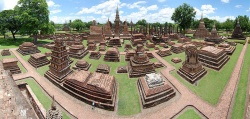Difference between revisions of "Sukhothai Historical Park"
| Line 2: | Line 2: | ||
| − | The '''[[Sukhothai Historical Park]]''' ([[Thai]]: อุทยานประวัติศาสตร์สุโขทัย | + | The '''[[Sukhothai Historical Park]]''' ([[Thai]]: [[อุทยานประวัติศาสตร์สุโขทัย]] covers the ruins of [[Wikipedia:Sukhothai Kingdom|Sukhothai]], capital of the [[Wikipedia:Sukhothai Kingdom|Sukhothai]] {{Wiki|kingdom}} in the 13th and 14th centuries, in what is now the [[north]] of [[Thailand]]. |
| − | + | It is located near the {{Wiki|modern}} city of [[Wikipedia:Sukhothai Kingdom|Sukhothai]], capital of the province with the same [[name]]. | |
| − | The [[protection]] of the area was first announced in the {{Wiki|Royal}} Gazette on June 6, 1962. In 1976 the restoration project was approved, and in July 1988 the park was officially opened. On December 12, 1991, it was declared a [[World Heritage Site]] as part of the Historic Town of [[Wikipedia:Sukhothai Kingdom|Sukhothai]] and Associated Historic Towns together with the associated historic parks in {{Wiki|Kamphaeng Phet}} and Si Satchanalai. | + | The city walls [[form]] a rectangle about 2 km east-west by 1.6 km north-south. |
| + | |||
| + | There are 193 ruins on 70 square kilometers of land. There is a gate in the centre of each wall. | ||
| + | |||
| + | Inside are the remains of the {{Wiki|royal}} palace and twenty-six [[temples]], the largest being [[Wat Mahathat]]. | ||
| + | |||
| + | The park is maintained by the [[Fine Arts]] Department of [[Thailand]] with help from [[UNESCO]], which has declared it a [[World Heritage Site]]. | ||
| + | |||
| + | The park sees thousands of visitors each year, who marvel at the [[ancient]] [[Buddha]] figures, palace buildings and ruined [[temples]]. | ||
| + | |||
| + | The park is easily toured by bicycle or even on foot. | ||
| + | |||
| + | The [[protection]] of the area was first announced in the {{Wiki|Royal}} Gazette on June 6, 1962. | ||
| + | |||
| + | In 1976 the restoration project was approved, and in July 1988 the park was officially opened. | ||
| + | |||
| + | On December 12, 1991, it was declared a [[World Heritage Site]] as part of the Historic Town of [[Wikipedia:Sukhothai Kingdom|Sukhothai]] and Associated Historic Towns together with the associated historic parks in {{Wiki|Kamphaeng Phet}} and Si Satchanalai. | ||
{{W}} | {{W}} | ||
[[Category:Buddhist Pilgrimages]] | [[Category:Buddhist Pilgrimages]] | ||
Latest revision as of 17:59, 4 February 2016
The Sukhothai Historical Park (Thai: อุทยานประวัติศาสตร์สุโขทัย covers the ruins of Sukhothai, capital of the Sukhothai kingdom in the 13th and 14th centuries, in what is now the north of Thailand.
It is located near the modern city of Sukhothai, capital of the province with the same name.
The city walls form a rectangle about 2 km east-west by 1.6 km north-south.
There are 193 ruins on 70 square kilometers of land. There is a gate in the centre of each wall.
Inside are the remains of the royal palace and twenty-six temples, the largest being Wat Mahathat.
The park is maintained by the Fine Arts Department of Thailand with help from UNESCO, which has declared it a World Heritage Site.
The park sees thousands of visitors each year, who marvel at the ancient Buddha figures, palace buildings and ruined temples.
The park is easily toured by bicycle or even on foot.
The protection of the area was first announced in the Royal Gazette on June 6, 1962.
In 1976 the restoration project was approved, and in July 1988 the park was officially opened.
On December 12, 1991, it was declared a World Heritage Site as part of the Historic Town of Sukhothai and Associated Historic Towns together with the associated historic parks in Kamphaeng Phet and Si Satchanalai.
